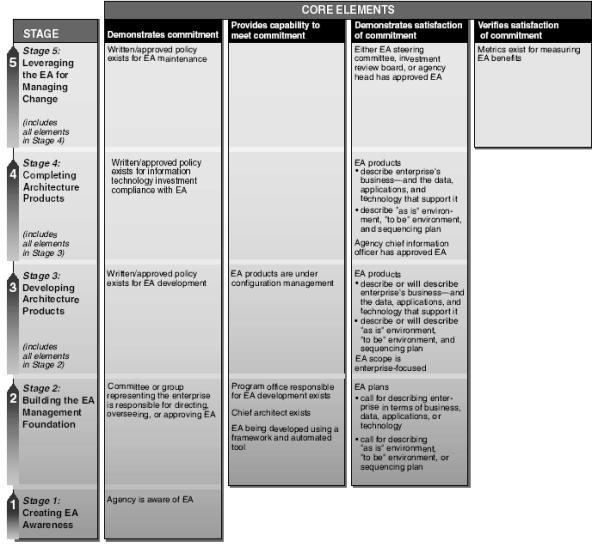
| Return to the USDOJ/OIG Home Page |
Federal Bureau of Investigation's Management of Information Technology Investments
Report No. 03-09
December 2002
Office of the Inspector General

|
Stage One: Creating Enterprise Architecture Awareness is characterized by either no plans to develop and use an enterprise architecture (EA), or plans and actions that do not yet demonstrate an awareness of the value of having and using one. While Stage One agencies may have initiated some EA core elements, these agencies’ efforts are ad hoc and unstructured, and do not provide the management foundation necessary for successful EA development. Stage Two: Building the EA Management Foundation focuses on assignment of roles and responsibilities and establishment of plans for developing EA products. Specifically, a Stage Two agency has designated a chief architect and established and staffed a program office responsible for EA development. Further, a steering committee or group that has responsibility for directing and overseeing the development has been established and the membership of the steering committee is comprised of business and IT representatives. At Stage Two, the agency either has plans for developing or has begun development of at least some of the necessary EA products. This stage also requires the agency to have selected both a framework that will be the basis for the nature and content of the specific products it plans to develop, and an automated tool to helpin the development. Stage Three: Developing Architecture Products focuses on actual development of EA products. At Stage Three, the agency has defined the scope of its EA as encompassing the entire enterprise, whether organization based or function-based, and it has a written and approved policy demonstrating institutional commitment. Although the products may not yet be complete, these products are intended to describe the agency in business, data, applications, and technology terms. Further, the products are to describe the current (i.e., “as is”) and future (i.e., “to be”) states and the plan for transitioning from current to future state (i.e., sequencing plan). Also, as the architecture products are being developed, these products are to be subject to configuration control. Stage Four: Completing EA Products is characterized by complete and approved EA products that the agency can use to help select and control its portfolio of IT investments. The complete products describe the agency in business, data, applications, and technology terms. Also, the products are complete in that the products describe the agency’s current and future states and the transition plan for sequencing from the current state to the future state. Further, the agency’s Chief Information Officer has approved the EA and the agency has a written policy requiring that IT investments comply with the EA. Stage Five: Leveraging the EA for Managing Changeentails evolving the products according to a written and approved policy for EA maintenance. Also at this stage, either the steering committee, investment eview board, or agency head approves the EA. Finally, the agency has incorporated the EA into its corporate decision-making and has established and is using metrics to measure the effectiveness of its EA. |
|
Source: GAO Report, “INFORMATION TECHNOLOGY: Enterprise Architecture Use across the Federal Government Can Be Improved” (GAO-02-6). |